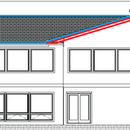Mixed roof insulation methods
Hello,
We are building a home near Ann Arbor, MI and would like some advice on how to approach a specific portion of our building section.
The majority of the home will have R60 blown in cellulose (blue areas) with Intello Plus underneath. The vaulted (red) area will be R60 closed cell foam. The walls will be EIFS, 2×6 R20 Roxul with 4″ EPS exterior foam.
Our concern is the clerestory wall (green and purple).
We will continue the EIFS on the exterior portion of the wall (green), but are a little unsure what to do on the vented ceiling/interior wall (purple) section.
We were thinking closed cell spray foam this area inside the attic and do Roxul on the interior. The IntelloPlus would then be tied into the spray foam to seal the whole section.
The other area of concern was the top of the clerestory wall where the closed cell spray (red) and the EIFS (green) come together. We don’t want to trap the sheathing between the closed cell foam and the rigid foam. Could someone make a recommendation?
Thanks,
Eric & Ryann
GBA Detail Library
A collection of one thousand construction details organized by climate and house part










Replies
I came up with this section drawing after I posted my questions...
The top of the clerestory wall should be OK with this method.
Eric & Ryann,
Your question may win the prize for the most confusing question of the week.
Before I puzzle through all the elements of your post, please tell me: Did you just solve your problem on your own? Or do you still need help?
Good morning Martin,
Sorry, but yes I think we did.
We were just looking for some confirmation that this was a reliable section plan and there were no major issues anyone could see. We would also appreciate any recommendations if we needed to do it differently.
-Eric & Ryann
Eric & Ryann,
I have added an arrow to the sketch below. Why do you need closed-cell spray foam in the area indicated by the arrow?
.
With the attic being vented I assumed we would need that wall to be fully insulated and air sealed.
Eric & Ryann,
Of course I believe in air sealing and insulation. I just noted that for the wall above the one where I placed the arrow, you used exterior rigid foam. In the area where I placed the arrow, you used closed-cell spray foam (which is environmentally damaging) instead of rigid foam, which is shown elsewhere. Why?
Designing the details for a wall between a conditioned space and an attic is easier than between a conditioned space and the outdoors, because it doesn't tend to rain in the attic, so the wall doesn't need to meet as many different requirements. So you have a lot of different options that can work there. Closed cell spray foam has a quite substantial global warming impact, unless you use Lapolla 4G foam, and it also has risk associated with improper application leading to a failure to cure and lingering odor problems. So I would not use spray foam anywhere that there are good alternatives. Unless I am missing something, you could use pretty much any other type of insulation on the attic side of that wall, with the caveat being that you'd want an air barrier of some sort on both sides of any fluffy insulation.
As you can guess, I'm not enthusiastic about the choice of ccSPF for the roof either, but that wasn't your question.
Just a sidenote on Charlie's mention of the Lapolla 4G foam (which I hadn't heard of before--looks cool!), Icynene Proseal Eco (MD-R-210) is another closed cell foam with a more reasonable global warming potential: http://www.icynene.com/en-us/architects/products/product-portfolio/proseal-eco-md-r-210-overview-architects
If you are going to be putting R-60 worth of ccSPF in your roof, do take a look at some of the newer foams with lower global warming potentials (or better yet, a hybrid foam + fluffy approach).